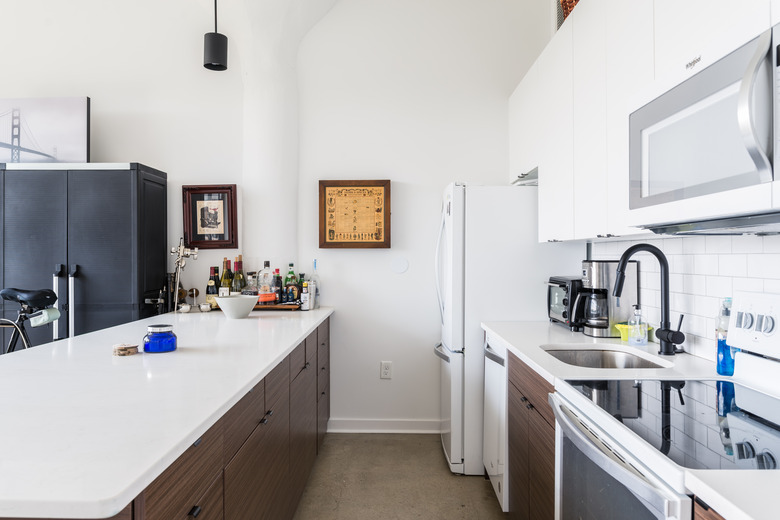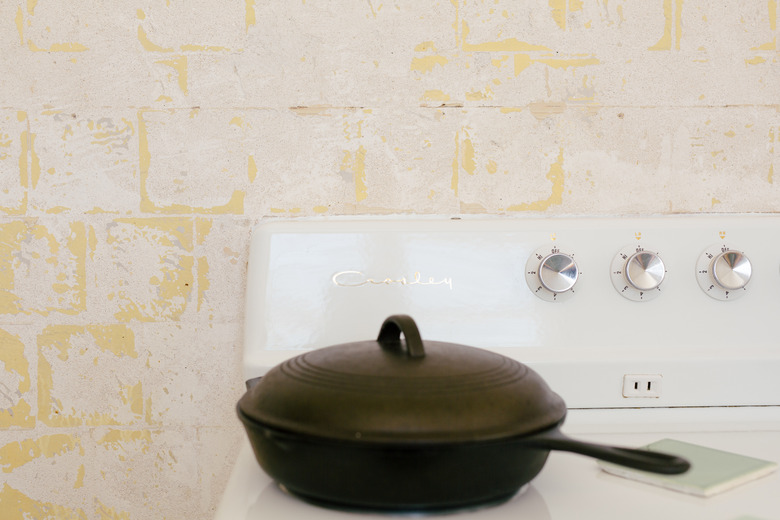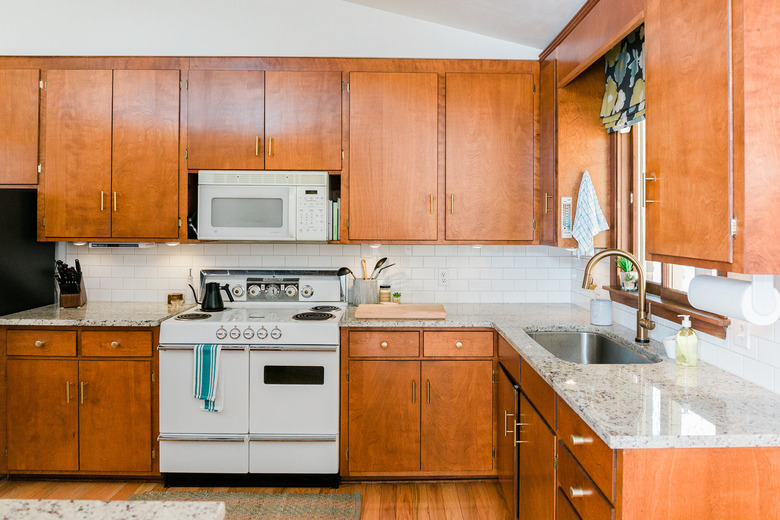How To Install A 4-Prong Range Cord
If you need to install a new four-prong range cord — one that fits a newer-style, four-slot range outlet — you almost certainly have one of two situations. Either you've bought or acquired a new range that came without a cord or you've recently moved your range from a house that had a three-slot outlet, and you need to replace the range's three-prong cord with a four-prong cord that fits your new home's four-slot outlet.
The good news is that any modern electric range can be connected with a four-prong cord, and the job should take only about 15 minutes. The basic procedure involves removing the cover on the electrical splice box on the back of the range, inserting the cord, connecting each of its wires to a terminal and then securing the cord with a simple cord bracket called a strain relief. Once that's done, you reinstall the cover and slide the range into place, and it's ready to plug in.
Depending on your situation, your range wiring may currently be set up for three-prong or four-prong wiring. If it's configured for three-prong, you'll need to make a minor change to the wiring in the splice box before connecting the new four-prong cord. If it's set up for four-prong, the installation is even simpler because it involves one less step.
Why New Ranges Have 4-Prong Cords
Why New Ranges Have 4-Prong Cords
In the 1996 edition of the National Electrical Code book (NEC), published by the National Fire Protection Association, there is an important change that henceforth affected the wiring for electric ranges and clothes dryers. In short, the NEC went from three-prong to four-prong, or more accurately, three-wire to four-wire.
Most local building codes follow the NEC, so sometime around 1996 to 2000, most cities began requiring four-wire circuits for electric ranges and dryers. The new laws dictate that all new installations of circuits and outlets for ranges and dryers must be four-wire. However, most local codes (and the NEC) allow homeowners to continue using their old three-wire cords and outlets if that's what they have in their homes. Three-wire has been "grandfathered" in.
Four-wire cords and circuits have two "hot" wires, one neutral wire and one ground wire. Three-wire cords and circuits have the same except there is no separate ground wire; they use the neutral as the ground path. This works fine most of the time, but there's a possibility of electric shock if the three-wire system has a short and the circuit breaker protecting the circuit fails to shut off. So, three-wire is generally safe but not as safe as four-wire.
The two hot wires each carry 120 volts for a total of 240. The range's timer, light, fan, electronics and other standard features use 120 volts; the heating elements and burners use 240. All 240-volt circuits in your home are protected by a 240-volt double-pole circuit breaker. Most are rated for 50 amps, indicated by the number 50 stamped on the breaker, but some range circuits are 40-amp and some are 60-amp.
Preparing Your Dryer for 4-Prong
Preparing Your Dryer for 4-Prong
Most electric ranges are sold without cords because homeowners may have either type of outlet. Therefore, when you buy a new range, you typically have to buy a new cord that matches your range outlet, be it four-slot or three-slot. Both types of cords install almost identically, with one important difference: the ground-neutral connection.
All ranges have a terminal block located inside their electrical splice box on the back of the appliance. The block has three terminals: a right hot terminal, a center neutral terminal and a left hot terminal. There's also a ground terminal or screw usually located to the side or below the terminal block.
When a range is set up for a three-prong cord, the ground and the neutral terminal are connected by a metal strap, or a small internal ground wire (usually with white insulation) that comes out of the back panel of the range and connects to the ground. The strap or wire ties the ground to the neutral wiring of the appliance.
With a four-wire configuration, the ground is separate. There is no strap or wire connecting it to the neutral. To prepare your range for a four-prong cord, make sure the ground is separate from the neutral. If there is a strap connecting the ground screw to the neutral terminal, remove the strap or loosen it and rotate it away from the neutral terminal. If there is an internal ground wire on the ground terminal, move the wire to the neutral terminal; this will harmlessly tie it to the neutral pathway.
Buying a 4-Prong Cord
Buying a 4-Prong Cord
Four-prong range cords are more or less standard, and most cord plugs fit most four-slot range outlets. The standard length is 4 feet. There are a few things for which to look when choosing a cord. The most important is the amperage rating. If your range circuit is 50 amp (check the number on the circuit breaker), use a 50-amp cord. Likewise, use a 40-amp cord for a 40-amp circuit and a 60-amp cord for a 60-amp circuit.
Also make sure the cord has a stamp or label signifying UL certification, which means it has been tested for safety by the UL organization (formerly known as Underwriters Laboratories). If a cord does not have ring-type terminals on the wire ends, look for one that does. This isn't necessary, but it makes hooking up the wires easier and more foolproof.
Finally, make sure the cord comes with a strain relief fitting. If not, buy a fitting that fits your cord. A strain relief is a two-piece metal clamp that secures the cord to the back of the appliance and prevents damage to the cord if it ever gets tugged. Do not install the new cord without a strain relief.
How to Install a 4-Prong (4-Wire) Range Cord
1. Shut Off the Power
Turn off the power to the range outlet's circuit by switching off its breaker in your home's service panel (breaker box). Your range won't be plugged in during the cord installation, but this is just an additional safety measure that ensures there's no chance that you'll power up the range until you're ready. You will switch the breaker back on for the final step of the process after the range is in place and ready to use.
2. Take Off the Splice Box Cover
Locate the metal access cover concealing the electrical splice box on the back of the range. Remove the cover screws with a screwdriver or nut driver. Remove the cover and set the plate and screws aside.
3. Remove the Old Cord (as Needed)
Disconnect and remove the old cord if applicable. Loosen each of the three screws or nuts securing the cord wires to the terminal block in the wiring splice box using a screwdriver or nut driver. Set the screws or nuts aside and pull each wire end from its terminal. Do the same with the ground wire if there is one.
Remove the screws on the strain relief fitting and separate and remove the two halves of the fitting. Pull the cord out through the hole in the range's back panel.
Note: If the old cord is three-prong, do not use its strain relief with the new four-prong cord; it won't fit the cord properly.
4. Make Sure the Ground Is Isolated
Prepare for the four-prong cord by confirming that the ground is isolated from the neutral terminal. Look at the ground screw or terminal next to the terminal block; it will likely have a green-colored screw or nut.
If there is a metal strap connecting the ground to the neutral (center) cord terminal on the terminal block, loosen the ground screw and neutral terminal screw and remove the metal strap, or you can leave it under the ground screw and rotate it away from the neutral terminal.
There may also be a small wire (usually with white insulation) coming out of the back of the range; this is an internal ground wire. If this wire is connected to the ground, remove the ground screw and move the wire to the neutral (center) terminal on the terminal block. You will connect both the small white wire and the white cord wire to the neutral terminal.
5. Connect the Four-Prong Cord
Feed the end of the cord through the hole in the back of the range. Hook the ring of the white (neutral) cord wire onto the center (neutral) terminal on the block and secure it with the terminal screw or nut. Connect the black cord wire to the left or right terminal using the same technique. Connect the red cord wire to the remaining terminal. The left and right terminals are interchangeable, but you must connect only one (red or black) wire to each terminal.
Connect the green ground wire to the ground screw. Tighten all screws very tightly and double check each to make sure it is secure.
6. Install the Strain Relief and Box Cover
Insert the upper and lower halves of the strain relief fitting into the hole where the cord goes in and adjust them so they rest onto the top and bottom of the cord, respectively. Squeeze the two halves together with tongue-and-grove pliers (or another type of large pliers) and install the two strain relief screws.
Tighten the screws a little bit at a time, alternating sides, so the clamp squeezes the cord evenly. The cord should be held firmly but don't make the clamp too tight so that you deform the cord or damage the cord insulation. Reinstall the splice box cover to complete the cord installation.
Setting and Testing Your Range
Setting and Testing Your Range
The last step is to position and plug in the range, turn on the power and give it a test drive. Most electric ranges have a secret passage that lets you reach the wall plug from the front side of the appliance. If you pull out and remove the drawer under the oven door, you'll see that there's no back to the drawer compartment. This allows you to reach through from the front to plug in or unplug the range before you slide the unit in or out of position. If you don't have this access opening, you'll simply have to move the range close to the outlet and plug in the range before you slide it into place.
Once the range is in position and is plugged in, check to make sure all of the burners and other controls are off and then switch on the circuit breaker to power up the circuit. Test drive all the burners and controls, and you're ready to cook!


